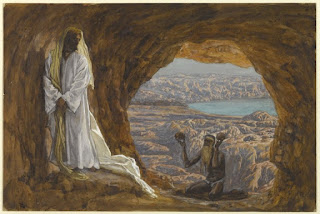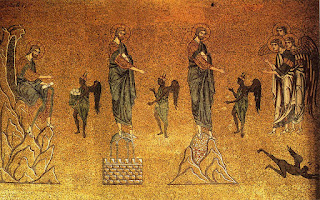The Surprising Truth About The Differences Between The Temptation Narratives of Matthew and Luke and What They Teach Us About Overcoming Temptation
We are now well into Lent, one of the two great fasts in the Christian Calendar (along with Advent).
Lent is the time when we contemplate Christ’s sacrifice,
along with Christ’s 40 days of temptation in the wilderness.
When we give up things for Lent we find ourselves tempted in
similar, yet far less extreme, circumstances (Let’s be honest, who wants to
hang out in the wilderness by themselves for 40 days and eat and drink nothing; I can
barely handle giving up chocolate!).
Much writing during this time consists of looking at the
temptations of Jesus, and how Jesus overcame them as a template for our own
overcoming of temptations.
But in this post, I do
not intend to look at the traditional views, but rather to look at the
differences between how Matthew and Luke told the story of Christ’s temptation
and what we can learn from these differences.
Let’s look at them now.
Why Differences are OK
We do not like to discuss differences in accounts of
Christ’s life.
Many scholars have sought to harmonise the accounts and remove
apparent contradictions.
But to do so is to read our own understandings of
historiography into the gospel writers. This does a disservice to scripture.
Rather we must acknowledge that the gospel writers had a
theological agenda for their writings, and
their agenda is valid (God obviously doesn’t have a problem with it).
The early church had no problems with apparent
contradictions. Eusebius, the early Church historian, quoting Papias (ad 60-130) on Mark’s gospel, writes:
Mark, being the interpreter of Peter, wrote accurately all that he remembered (but not, however, in order) [of] the things which were spoken or done by our Lord
Here we see the early church acknowledging that the gospel of Mark is not in chronological order of what happened in Jesus’ life.
Equally Matthew and Luke wrote down the temptations of Jesus
in different orders, to add theological emphasis, and this is okay.
The Differences in Matthew and Luke
In both gospels, Jesus
undergoes 3 temptations by Satan.
In both gospels, the 3
temptations were the same.
In both gospels,
Christ answers the temptations in the same way – by quoting scripture.
The primary difference is in the ordering.
The primary difference is in the ordering.
Matthew
In the gospel of Matthew, the temptations are:
Jesus is told to turn stones into bread to satiate his hunger.
↓
Jesus is taken to the top of the Temple and asked to jump off and let angels catch him.
↓
Jesus is taken to a very high mountain, shown the kingdoms
of the world and told that they would be his if he could bow to Satan.
Luke
In the gospel of Luke The temptations are:
Jesus is told to turn stones into bread to satiate his hunger.
↓
Jesus is taken to a very high mountain, shown the kingdoms
of the world and told that they would be his if he could bow to Satan.
↓
Jesus is taken to the top of the temple and asked to jump off and let angels catch him.
Let us look at what we can learn from these in more detail.
Matthew
Matthew's theological orient is to look at Jesus within his
Jewish context.
There is a large amount of evidence to suggest that Matthew
was writing his gospel with Jewish people in mind.
For example, when Matthew mentions Jewish customs he does
not give any explanation of what the customs are, he assumes that his reader
already has a good knowledge of Jewish Customs.
Matthew traces his genealogy of Jesus only as far back as Abraham, the Jewish patriarch.
Matthew traces his genealogy of Jesus only as far back as Abraham, the Jewish patriarch.
Another example is his use of the phrase “the Kingdom of Heaven” rather than the phrase used
in the other gospels “Kingdom of God”. Jews did not want to use the word “God”
as it is something to be revered and holy and so Matthew uses the word heaven
instead (hence why in some books you may see the word “G-d”, the modern
iteration of this custom).
Jesus As The New Moses
Another of Matthew's aims in his gospel is to draw a parallel between Jesus and Moses – the man who led the Israelites out of slavery in Egypt (not sure who Moses is? Then watch the film “The Prince ofEgypt”, it might not be totally accurate, BUT THE SONGS ARE SO GREAT!!!... there can be miracles).
We see this parallel between Jesus and Moses played out in
many forms, including:
1.
- Pharaoh decreed all Hebrew male babies were to be killed, Moses lives (Exodus 1:22, Exodus 2:1-2).
- Pharaoh decreed all Hebrew male babies were to be killed, Moses lives (Exodus 1:22, Exodus 2:1-2).
- Herod decreed all Hebrew male babies were to be killed,
Jesus lives (Matthew 2:16-18)
2.
- Moses is given the law whilst up a mountain (Exodus 24:1-3)
- Moses is given the law whilst up a mountain (Exodus 24:1-3)
- Jesus delivers new law whilst on a mountain (the sermon on
the mount) (Matthew 5:1-3)
3.
- The first five books of the Bible (the Torah) were considered to be “the books of Moses” and were believed to have been written by Moses.
- The first five books of the Bible (the Torah) were considered to be “the books of Moses” and were believed to have been written by Moses.
- Jesus delivers five extended sermons in Matthews gospel
(Matthew 5-7, 10, 13, 18, 24-25)
All of this points to Matthew ordering his gospel in a very
Jewish way. And by extension, ordering his temptation narrative in a very
Jewish way.
How does he do this?
The Temptation Narrative and The New Moses
We can see the temptations of Jesus itself as a comparison between Jesus and Moses.
Jesus ate and drank nothing for 40 days whilst he was in the
desert.
Equally, Moses ate and drank nothing for 40 days whilst he was on Mount Sinai receiving the law (Exodus 34:28).
Equally, Moses ate and drank nothing for 40 days whilst he was on Mount Sinai receiving the law (Exodus 34:28).
It was upon mount Sinai that Moses received the law. The law
was what established the covenant between God and Israel. The law was the boundary marker that separated Israel from the
surrounding nations.
Equally, Jesus also
came to establish a covenant. A new covenant where the law would be written on
people’s hearts, instead of on stone tablets (Jeremiah 31:33).
Therefore, considering the large parallels between Jesus and
Moses, and specifically the giving of the law on mount Sinai with Jesus’
temptations in the wilderness, that Jesus ends up standing on a mountain, just
as Moses did.
Matthew ends his temptation narrative with Jesus stood upon
a mountain, as the bringer of a new covenant. A very Jewish idea, rooted in the
history of Israel.
Now let’s turn to Luke
Luke
Luke’s gospel is rather different than Matthews.
Whilst Matthew is written for a Jewish audience, Luke’s narrative is written for a gentile audience, by a gentile.
Whilst Matthew is written for a Jewish audience, Luke’s narrative is written for a gentile audience, by a gentile.
Some evidence of this can be seen by Luke:
- Writing the book for a gentile (Luke 1:3)
- Tracing the line of Jesus right back to Adam (as opposed to Matthew tracing it only back to Abraham). (Luke 3:38)
Halfway through Luke’s gospel,
we are given a large clue as to the direction that Luke is taking us.
In Luke 9:51 we read:
When the days drew near for him to be taken up, he set his face to go to Jerusalem.Thus we see the direction of his gospel.
Jesus sets his face towards Jerusalem, and the rest of the
narrative is taken up with Jesus’ slow movement towards his betrayal, torture
and death in (and just outside of) Jerusalem.
Therefore we can see the entire gospel echoed within the
temptation narrative. The temptation itself being a microcosm of Luke’s gospel.
Jesus starts off in the desert, moving to the mountain, and
finally ending up at… Jerusalem.
Conclusion
Both renderings of the temptation arrive at the same
conclusion via different means.
Both narratives end where Jesus himself chose to end: with
his death and resurrection establishing a new covenant with the world.
One narrative focuses on Jesus physical journeying or
arriving at this new covenant, through his triumphal entry into Jerusalem,
ending in his death and resurrection (Luke).
The other narrative focuses on the spiritual ramifications
of this physical journey, that a new covenant would be established and a new law established, this time through the
spirit of God and through reconciliation (Matthew).
What does this teach us about temptation?
Yes, there are all the parts about knowing scripture that we have heard before. And all this is important.
But what about using our approach?
In both narratives,
Jesus is heading somewhere, to something greater than himself. He has a
direction, somewhere he wants to get to. Specifically, the redemption of
mankind, the establishment of a new covenant and the restoration of a new Eden.
Falling into temptation would have taken Jesus off of this
path.
When we are faced with temptation, do we know where we are
headed? Not in a heaven or a hell way, I am not talking about soteriology as
such, but rather, to what are we being called into?
We are being called into eternity.
We are being called into being
daughters and sons of God, by God.
We are being prepared for eternity, and so it is that we see
our eternal perspective.
I would love to hear what you have learnt during this lent, or what you have given up. Let me know in the comments below.








I would like one piece of suggestion that ,according to Luke it is a stone to become bread . Only singular used by Luke but Matthew is saying stones to become bread, plural form used by Matthew . But in these article both places used plural form where does Bible don't say about it.
ReplyDeleteThank you.
Could you over an answer to why Matthew says that Jesus was tempted of the devil after he had finished the 40 days and nights of fasting, but Luke says that Jesus was tempted during the 40 days and nights of fasting.
ReplyDeletehello, perhaps you a reading a particular translation? If you read the ESV, you will see that Luke 4:1-2 doesn't actually say that the temptation took place during the 40 days of fasting. What it does say is: "... wilderness for forty days, being tempted by the devil. And he ate nothing during those days. And when they were ended, he was hungry." It tells us that he ate nothing for 40 days and it tells us that when those 40 days were over, he was hungry. Now, verse 3 begins with Satan telling Jesus to turn the stone into bread. What this says to me is that the three recorded temptations did in fact take place after the 40 days of fasting. It seems to me, Luke has given us extra info that Matthew doesn't - that Jesus was also tempted during his 40 days of fasting, with what we don't know, but what the gospel writers focus on are the three temptations after his 40 days of fasting.
DeleteThis story means a lot to Christians because it is able to show us how to handle temptation and it also shows us the strength and love that Jesus had. The story about Satan tempting Jesus in the wilderness teaches us a Gospel of Mark states that Jesus was tempted in the wilderness. https://catalyticministries.com/sheep-among-wolves/
ReplyDeleteWhat about mark
ReplyDelete